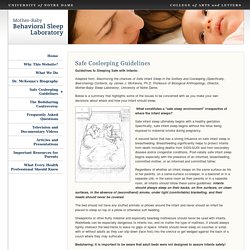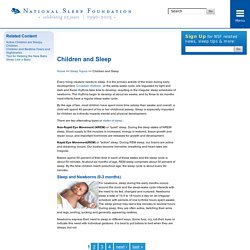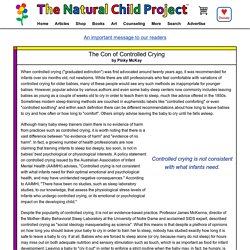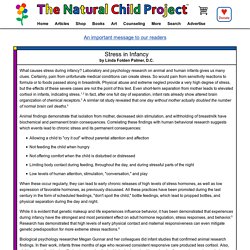

Sleep. Facts. Loewe l cis190 informationgathering. Loewe l cis190 researchproposal. Loewe l referencesresearchproject. Crying It Out. Why Is Comforting Your Baby So Important? When Your Baby Won't Stop Crying: How to Comfort and Soothe an Upset or Colicky Baby. Calming and soothing a crying baby It is common to feel frustration, anxiety, and even anger when faced with a crying baby—especially if your baby wails for hours on end and won’t calm down.

Equally frustrating is a baby who seems indifferent, upset, or who won’t cuddle or make eye contact with you. In stressful situations like this—when your baby won’t stop crying or won’t respond to you and when you are feeling frustrated, tired and angry—you need to develop some strategies for taking care of yourself. When you’re calm and centered, you’ll be better able to figure out what’s going on with your child and soothe his or her cries. NEVER NEVER shake a baby Shaken Baby Syndrome occurs when a baby is shaken. Each year about 1,000 children die from Shaken Baby Syndrome. Source: American Academy of Pediatrics Coping with a crying, colicky, or unresponsive baby Recognize your limits. Safe Cosleeping Guidelines // Mother-Baby Behavioral Sleep Laboratory // University of Notre Dame. Guidelines to Sleeping Safe with Infants: Adapted from: Maximizing the chances of Safe Infant Sleep in the Solitary and Cosleeping (Specifically, Bed-sharing) Contexts, by James J.

McKenna, Ph.D. Professor of Biological Anthropology, Director, Mother-Baby Sleep Laboratory, University of Notre Dame. Below is a summary that highlights some of the issues to be concerned with as you make your own decisions about where and how your infant should sleep. What constitutes a "safe sleep environment" irrespective of where the infant sleeps? Safe infant sleep ultimately begins with a healthy gestation. A second factor that has a strong influence on safe infant sleep is breastfeeding. The bed should not have any stuffed animals or pillows around the infant and never should an infant be placed to sleep on top of a pillow or otherwise soft bedding.
Sheepskins or other fluffy material and especially beanbag mattresses should never be used with infants. Sleeping Like a Baby? By Jennifer Slatton Austin TX USA From: NEW BEGINNINGS, Vol. 20 No. 1, January-February 2003, p. 4 When did you go to sleep last night?

8 pm? 10 pm? Midnight? When do you think your great grandparents typically fell asleep? So many of us have heard other mothers claim that their newborns sleeps 10-to-12-hour stretches at night. Children & Sleep. By the age of two, most children have spent more time asleep than awake and overall, a child will spend 40 percent of his or her childhood asleep.

Sleep is especially important for children as it directly impacts mental and physical development. There are two alternating types or states of sleep : Non-Rapid Eye Movement (NREM) or "quiet" sleep. The Con of Controlled Crying. After a week of controlled crying he slept, but he stopped talking (he was saying single words).

For the past year, he has refused all physical contact from me. If he hurts himself, he goes to his older brother (a preschooler) for comfort. I feel devastated that I have betrayed my child. - Sonia It is the very principle that makes controlled crying "work" that is of greatest concern: when controlled crying "succeeds" in teaching a baby to fall asleep alone, it is due to a process that neurobiologist Bruce Perry calls the "defeat response". Our six-month-old baby is unable to fall asleep on his own. He needs to be nursed or held to fall asleep. My family says it's time for him to soothe himself, but I'm unsure how to go about it. Stress in Infancy. What causes stress during infancy?

Laboratory and psychology research on animal and human infants gives us many clues. Certainly, pain from unfortunate medical conditions can create stress. So would pain from sensitivity reactions to formula or to foods passed along in breastmilk. Physical abuse and extreme neglect provide a very high degree of stress, but the effects of these severe cases are not the point of this text. Children Need Touching and Attention, Harvard Researchers Say.
By Alvin Powell Contributing Writer America's "let them cry" attitude toward children may lead to more fears and tears among adults, according to two Harvard Medical School researchers.

Instead of letting infants cry, American parents should keep their babies close, console them when they cry, and bring them to bed with them, where they'll feel safe, according to Michael L. Dangers of “Crying It Out” The Cry-It Out Method: How effective is this method for infants? Cry it Out (CIO) - Atachment Parenting - Leave Baby to Cry. Among parents of infants these days, there is constant debate about how to respond to a baby’s cries.

On one hand, there are proponents of the “cry it out” method, where the baby is left alone to cry in the hopes that he or she will eventually stop. On the other hand, there are the “attachment parents” who respond immediately to their crying babies and attempt to soothe them using various methods including holding and cuddling. CIO? at StorkNet's Attachment Parenting Cubby. What is CIO?

CIO stands for "cry-it-out". I am not quite sure what the "it" is referring to, but CIO involves leaving a baby or young child to cry himself to sleep, in an effort to teach the child to sleep through the night. The Trusted Resource for Parents. If only my baby could talk instead of cry I would know what she wants,” said Janet, a new mother of a fussy baby.

“Your baby can talk,” we advised. “The key is for you to learn how to listen. When you learn the special language of your baby’s cry, you will be able to respond sensitively. Here are some listening tips that will help you discover what your baby is trying to say when he cries. The cry is not just a sound; it’s a signal – designed for the survival of the baby and development of the parents.